Saints of the Day
 |
 |
 |
 |
 |
 |
 |
St. Erminold - January 7
Biographical selection
St. Erminold was a saint characteristic of the 12th century when the German clergy started to fight tenaciously against the Emperors who wanted to take over the rights of the Church. Catholic Germany would have been lost without the valor of various faithful Bishops and the resistance of the Benedictine monks who had an admirable rigor, probably inspired by the influence of Cluny. St. Erminold was one such noble soldier in this fight whose courage won him the glory of martyrdom.
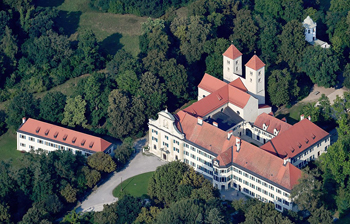
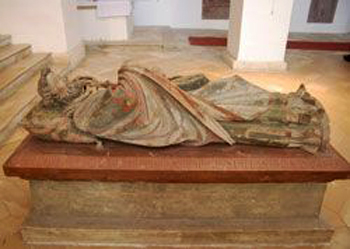 Erminold was born of noble parents in Swabia (one of the four original provinces of Germany). He was raised in the Monastery of Hirschau, a local monastery, under the direction of an extraordinary master, William, whose example he followed so perfectly that he was called the Eliseus of that new Elias. His virtues attracted the attention of the Emperor Henry V, who appointed him Abbot of the Royal Abbey of Lorsch. During his short term of office there, he transformed the monastery into a garden of God and an image of Paradise.
Erminold was born of noble parents in Swabia (one of the four original provinces of Germany). He was raised in the Monastery of Hirschau, a local monastery, under the direction of an extraordinary master, William, whose example he followed so perfectly that he was called the Eliseus of that new Elias. His virtues attracted the attention of the Emperor Henry V, who appointed him Abbot of the Royal Abbey of Lorsch. During his short term of office there, he transformed the monastery into a garden of God and an image of Paradise.
The Emperor, however, asked Erminold's brother for rich gifts in exchange for giving the Abbey of Lorsch to the Saint. When he learned about this demand, Erminold, who fled from simony as from leprosy, left the Abbey and returned to Hirshau. He was followed by 40 monks.
Around this time, St. Otto, Bishop of Bamberg, fleeing the ruckus of the court of Regensburg, went to the countryside. One day at dusk he heard the joyful sound of bells in the nearby hills. He also saw a staircase like that of Jacob, which rose up to Heaven with Angels going up and down it. St. Otto recognized this vision as a sign that God wanted him to build an abbey there, and thus he built Prüfening Abbey on that site. Then Bishop Otto named St. Erminold as its first Abbot in 1114.
The firm rule of the Abbot of Prüfening is clear from the following incident. In 1119 Pope Calixtus II excommunicated Emperor Henry V, who was carrying on the tyrannical policy of his father in the struggle against the Papacy. One day the Emperor announced he would visit the Abbot of Prüfening. St. Erminold did not hesitate to take an inflexible attitude.
He went alone to the door of the Abbey and, addressing the Emperor, he said: "Sire, I would receive Your Lordship with all due royal honors if I did not know that our Apostolic Lord [the Pope] had separated Thee from the Church."
 Henry stepped forward and responded: "We should not deny hospitality to any person. As for the excommunication, it is not fair."
Henry stepped forward and responded: "We should not deny hospitality to any person. As for the excommunication, it is not fair."
The man of God responded: "How could I doubt this sentence [caused by the Emperor's simony] when I had to renounce my office as Abbot for the same reason?"
A threatening murmur of hatred rose among those who accompanied Henry. The latter, impressed by the courage of the Holy Abbot, slowly retired from the place.
St. Erminold would die murdered by certain monks who resented his vigilance and strict rule. In their first attempt to murder him, they failed because one of the monks repented and alerted the Abbot about the plot. In the second attempt he was fatally wounded by one of the monks who gave him a blow on the head with a heavy piece of wood.
He died a few days later on the feast of the Epiphany in the year 1121 when the Gloria in Excelsis Dei – the solemn hymn of the Monastery – was being chanted, at the hour he is said to have foretold. c This selection is magnificent for its content and deplorable for its description. Indeed, it reports many admirable things but adopts a language that smothers the sonority of the admirable things so much that it acts as a veritable damper.
You see a history here that unfolds like a legend, a story that would deserve a whole façade of a cathedral with sculptures representing the deeds and words of St. Erminold. But his history is presented in such way that we do not feel anything of its glorious and heroic aspects.
For example, the author mentions that St. Erminold was a soldier in the fight against the interference of the Emperors in Church affairs. We should imagine him as a medieval soldier like the figure of the Credo knight: a man ready to go to war or already engaged in battle, fighting to defeat and terrorize the enemies. We should imagine him with all the panache of a great medieval warrior.
In the Middle Ages war depended much more on the strength of the knights than on war engines, which were still very primitive. The decisive factor was the individual courage and strength of the knight, who was mounted on his horse and was superior to the pawns, or foot soldiers. The knight was the great instrument of victory. So then, St. Erminold should be seen this way. The selection gives no notion of this.

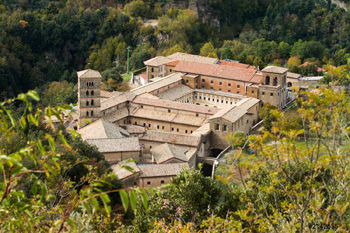 Next, the life in a monastery comes to our attention. I have the impression that some of us do not have an objective idea of what life in a medieval monastery was. We are led to imagine it was similar to life in a baroque Brazilian monastery or in one of the monasteries in this neighborhood, such as those next to the Immaculate Heart of Mary Church or St. Therese of Lisieux Church. I believe we would benefit from a slide show displaying some of the medieval monasteries of Europe.
Next, the life in a monastery comes to our attention. I have the impression that some of us do not have an objective idea of what life in a medieval monastery was. We are led to imagine it was similar to life in a baroque Brazilian monastery or in one of the monasteries in this neighborhood, such as those next to the Immaculate Heart of Mary Church or St. Therese of Lisieux Church. I believe we would benefit from a slide show displaying some of the medieval monasteries of Europe.
They had a grandeur that we can hardly imagine. They were composed of a succession of buildings that – when they were in a city – would occupy six or seven blocks without any cross streets. Sometimes they would be surrounded by high walls separating them from the movement of the city.
The dormitory of the monks was also enormous with room for 50 or 60 monks, each with a simple bed, but carved in oak, giving the impression of a great stability. Tall stained glass windows rose to the ceiling representing scenes of Sacred History. At the end of the dormitory stood a statue brought from the Crusades and known for the miracles it had worked; before it an oil lamp was always lit. That statue presided over the sleep of the monks.
The bells were made by dynasties of bell-makers who passed on the secrets of their craft to family members who would not reveal them to anyone outside the family. Those secrets would give their bells the sonority and expression that made them famous all over Europe.
This was the ambience in which St. Erminold lived.
Further on, the selection mentions the Emperor. There is nothing that explains what a medieval Emperor was. Today no one has an idea of the pomp and high respect that surrounded a medieval Emperor, which came from the understanding everyone had that his power came from God. Consequently, there is no notion of the force of soul that would be necessary to confront the Emperor in name of God, as St. Erminold did. It represented a fullness of soul, a sanctity of which we cannot have an idea in hearing the reading of a selection like this.
So, all these words and biographical data of the selection do not proffer us the ambience that allows us to comprehend the personality of St. Erminold.
We should imagine him as a warrior who became old, but not that type of worn-out old man of our polluted days, but rather a majestic old man who stands like an oak that dominates a whole prairie.
He presented himself in his small Abbot's miter and carrying his staff at the door of the monastery. On the other side of the door was the Emperor with his grand entourage. It was the confrontation of the spiritual and temporal powers. He said to Emperor: "Your Lordship cannot enter." This was the scene; this was the man, this was St. Erminold.
What should we ask of this Saint? We should ask that, despite our weaknesses, he concede to us some of the great strength of soul that he had; thus, no matter how great the person is whom we have to confront, we will not be small in face of him. We should ask him that, before the adversary – no matter how wealthy, powerful, influential he be, no matter how able he is to crush us, isolate us, make fun of us, wound us or kill us – we will always have the same force of soul that he had. We should ask him for the virtue of fortitude.
When we pray for a long time, insistently, the grace we ask for comes. Thus should we look at the example of St. Erminold with confidence and ask Our Lady to give us this type of personality. Even should she delay in giving it to us, when the necessary moment comes we will have this grace. She never abandons us in the hour when duty calls without giving us the necessary strength to fulfill our duty completely.
This is the great truth with which we close these comments.


The Saint of the Day features highlights from the lives of saints based on comments made by the late Prof. Plinio Corrêa de Oliveira. Following the example of St. John Bosco who used to make similar talks for the boys of his College, each evening it was Prof. Plinio’s custom to make a short commentary on the lives of the next day’s saint in a meeting for youth in order to encourage them in the practice of virtue and love for the Catholic Church. TIA thought that its readers could profit from these valuable commentaries.
The texts of both the biographical data and the comments come from personal notes taken by Atila S. Guimarães from 1964 to 1995. Given the fact that the source is a personal notebook, it is possible that at times the biographic notes transcribed here will not rigorously follow the original text read by Prof. Plinio. The commentaries have also been adapted and translated for TIA’s site.
St. Erminold was a saint characteristic of the 12th century when the German clergy started to fight tenaciously against the Emperors who wanted to take over the rights of the Church. Catholic Germany would have been lost without the valor of various faithful Bishops and the resistance of the Benedictine monks who had an admirable rigor, probably inspired by the influence of Cluny. St. Erminold was one such noble soldier in this fight whose courage won him the glory of martyrdom.

St. Erminold the first Abbot of Prüfening, above;
below, his tomb in this Abbey

The Emperor, however, asked Erminold's brother for rich gifts in exchange for giving the Abbey of Lorsch to the Saint. When he learned about this demand, Erminold, who fled from simony as from leprosy, left the Abbey and returned to Hirshau. He was followed by 40 monks.
Around this time, St. Otto, Bishop of Bamberg, fleeing the ruckus of the court of Regensburg, went to the countryside. One day at dusk he heard the joyful sound of bells in the nearby hills. He also saw a staircase like that of Jacob, which rose up to Heaven with Angels going up and down it. St. Otto recognized this vision as a sign that God wanted him to build an abbey there, and thus he built Prüfening Abbey on that site. Then Bishop Otto named St. Erminold as its first Abbot in 1114.
The firm rule of the Abbot of Prüfening is clear from the following incident. In 1119 Pope Calixtus II excommunicated Emperor Henry V, who was carrying on the tyrannical policy of his father in the struggle against the Papacy. One day the Emperor announced he would visit the Abbot of Prüfening. St. Erminold did not hesitate to take an inflexible attitude.
He went alone to the door of the Abbey and, addressing the Emperor, he said: "Sire, I would receive Your Lordship with all due royal honors if I did not know that our Apostolic Lord [the Pope] had separated Thee from the Church."

A firm refusal to allow the excommunicated Emperor
to enter his Abbey
The man of God responded: "How could I doubt this sentence [caused by the Emperor's simony] when I had to renounce my office as Abbot for the same reason?"
A threatening murmur of hatred rose among those who accompanied Henry. The latter, impressed by the courage of the Holy Abbot, slowly retired from the place.
St. Erminold would die murdered by certain monks who resented his vigilance and strict rule. In their first attempt to murder him, they failed because one of the monks repented and alerted the Abbot about the plot. In the second attempt he was fatally wounded by one of the monks who gave him a blow on the head with a heavy piece of wood.
He died a few days later on the feast of the Epiphany in the year 1121 when the Gloria in Excelsis Dei – the solemn hymn of the Monastery – was being chanted, at the hour he is said to have foretold. c This selection is magnificent for its content and deplorable for its description. Indeed, it reports many admirable things but adopts a language that smothers the sonority of the admirable things so much that it acts as a veritable damper.
You see a history here that unfolds like a legend, a story that would deserve a whole façade of a cathedral with sculptures representing the deeds and words of St. Erminold. But his history is presented in such way that we do not feel anything of its glorious and heroic aspects.
For example, the author mentions that St. Erminold was a soldier in the fight against the interference of the Emperors in Church affairs. We should imagine him as a medieval soldier like the figure of the Credo knight: a man ready to go to war or already engaged in battle, fighting to defeat and terrorize the enemies. We should imagine him with all the panache of a great medieval warrior.
In the Middle Ages war depended much more on the strength of the knights than on war engines, which were still very primitive. The decisive factor was the individual courage and strength of the knight, who was mounted on his horse and was superior to the pawns, or foot soldiers. The knight was the great instrument of victory. So then, St. Erminold should be seen this way. The selection gives no notion of this.

Medieval monasteries: above Eberbach Abbey, a Cistercian monastery in Germany; below, the Cistercian Abbey of Fontenay in France
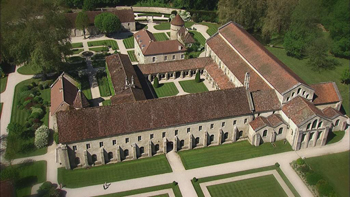
Below, Abbey of Saint Scholastica, in Subiaco, Italy

They had a grandeur that we can hardly imagine. They were composed of a succession of buildings that – when they were in a city – would occupy six or seven blocks without any cross streets. Sometimes they would be surrounded by high walls separating them from the movement of the city.
The dormitory of the monks was also enormous with room for 50 or 60 monks, each with a simple bed, but carved in oak, giving the impression of a great stability. Tall stained glass windows rose to the ceiling representing scenes of Sacred History. At the end of the dormitory stood a statue brought from the Crusades and known for the miracles it had worked; before it an oil lamp was always lit. That statue presided over the sleep of the monks.
The bells were made by dynasties of bell-makers who passed on the secrets of their craft to family members who would not reveal them to anyone outside the family. Those secrets would give their bells the sonority and expression that made them famous all over Europe.
This was the ambience in which St. Erminold lived.
Further on, the selection mentions the Emperor. There is nothing that explains what a medieval Emperor was. Today no one has an idea of the pomp and high respect that surrounded a medieval Emperor, which came from the understanding everyone had that his power came from God. Consequently, there is no notion of the force of soul that would be necessary to confront the Emperor in name of God, as St. Erminold did. It represented a fullness of soul, a sanctity of which we cannot have an idea in hearing the reading of a selection like this.
So, all these words and biographical data of the selection do not proffer us the ambience that allows us to comprehend the personality of St. Erminold.
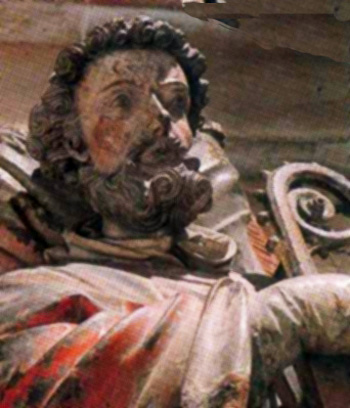
St Erminold, a grandiose and imposing figure who could calmly confront an Emperor
He presented himself in his small Abbot's miter and carrying his staff at the door of the monastery. On the other side of the door was the Emperor with his grand entourage. It was the confrontation of the spiritual and temporal powers. He said to Emperor: "Your Lordship cannot enter." This was the scene; this was the man, this was St. Erminold.
What should we ask of this Saint? We should ask that, despite our weaknesses, he concede to us some of the great strength of soul that he had; thus, no matter how great the person is whom we have to confront, we will not be small in face of him. We should ask him that, before the adversary – no matter how wealthy, powerful, influential he be, no matter how able he is to crush us, isolate us, make fun of us, wound us or kill us – we will always have the same force of soul that he had. We should ask him for the virtue of fortitude.
When we pray for a long time, insistently, the grace we ask for comes. Thus should we look at the example of St. Erminold with confidence and ask Our Lady to give us this type of personality. Even should she delay in giving it to us, when the necessary moment comes we will have this grace. She never abandons us in the hour when duty calls without giving us the necessary strength to fulfill our duty completely.
This is the great truth with which we close these comments.

 | |
|
|
The texts of both the biographical data and the comments come from personal notes taken by Atila S. Guimarães from 1964 to 1995. Given the fact that the source is a personal notebook, it is possible that at times the biographic notes transcribed here will not rigorously follow the original text read by Prof. Plinio. The commentaries have also been adapted and translated for TIA’s site.


